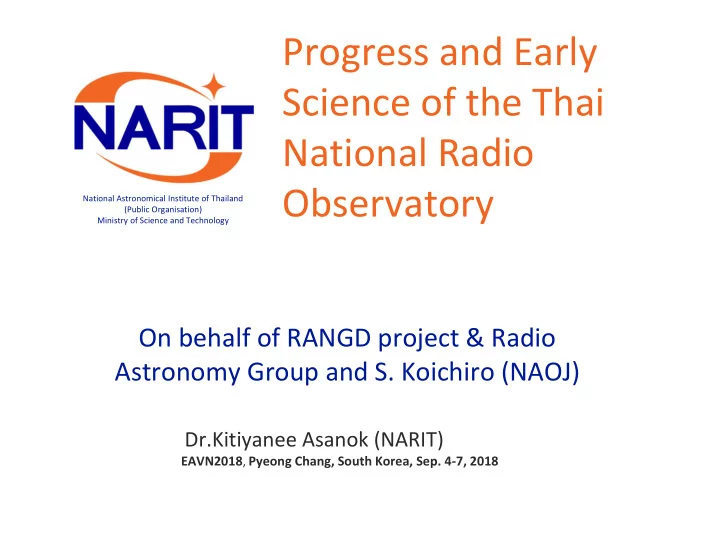

Progress and Early Science of the Thai National Radio Observatory National Astronomical Institute of Thailand (Public Organisation) Ministry of Science and Technology On behalf of RANGD project & Radio Astronomy Group and S. Koichiro (NAOJ) Dr.Kitiyanee Asanok (NARIT) EAVN2018 , Pyeong Chang, South Korea, Sep. 4-7, 2018
Radio Astronomy Network and Geodesy for Development (RANGD) 2017-2021 “Capacity Building Through Radio Astronomy” • Thai National Radio Observatory ( TNRO ) • 40m Thai Radio Telescope ( TNRT ) • 13m VGOS Telescope • Visitor Centre • Receiver and Electronics Laboratories Human Expertise • Workshops & Seminars • Trainings & Staff exchange
Background of TNRT Multipurpose ~40m RT — with flexibility • (preferably) Existing Design — limited experience • Frequency ~ UHF - ~115 GHz — determined by Science area, • Radio Frequency Interference, Weather conditions Key attributes Extensive observing frequency : 300 MHz - 115 GHz • Ideal latitude location : +18 N • Single Dish Applications focus on Time Domain astronomy , such as pulsars and radio transients and variability of masers and extra-galactic sources.
RANGD International Technical Advisory Committee (1st Meeting; March ’18) 2 nd Meeting will be ~Nov. 2018
RANGD Phase I (2017-2018) Timeline 2018 2019 2020 Sitework 40m TNRT Installation L-, K-band Backend SAT Science Commissioning
40m Thai National Radio Telescope 40 40m Ye Yebes, , Spain • `Updated’ version of IGN’s 40m Yebes Radio Telescope • 40m Paraboloid Antenna, Cassegrain-Nasmyth optics • 300 MHz - 115 GHz • Multi-propose Antenna • Geodesy & Time standards • Strategic location for VLBI observation • Generates demand for R&D on State-of-the-art technology 40m RT Contract Signing March ‘17
L-band K-band Sensitivity Location Primary Focus Nasmyth Focus Frequency ra range (G (GHz) 1. 1.0-1.8 18 18.0-26.5 Centre wavelength (c (cm) 21.4 1.36 Beam wid idth (a (arcmin in) 22 1.4 Polarisation Linear Circular Cross po polarisation -25 dB -25 dB RF BW 80 800 MHz 8 GHz sampler 3 Gsps >4 Gsps Packetizer BW 1.5 GHz >2 2 GHz dig igitisation bi bits < 12 bit < 12 bit Total eff fficie iency 0.7 0.5 Gain in (K (K/Jy) 0.32 0.23 Trx (K (K) 13 20 Tsky (K (K) 12 50 Tsys (K (K) 25 70 SEFD (Jy Jy) 78 78 30 304
System Diagram Develop a single unit capable of pulsar mode; coherent • dedispersion, full-stokes filterbank files, transient search spectral-line mode; CLASS • format (GILDAS) write vdif to mark6 • Pros • expandability; flexibility; real-time RFI excision; COTS components Cons • low performance per watt (not a problem for single pixel Rx)
Participating in VLBI networks e-VLBI?
6m foundation excavation +6m piles
RANGD Phase I+II Timeline 2018 2019 2020 2021 Sitework 40m TNRT Installation L-, K-band Backend SAT Science Commissioning C-band Rx (TBC) Q+W Rx (TBC) 13m VGOS (SHAO)
Time-domain Astronomy ( S. Koichiro, NAOJ ) Key advantages Extensive observing frequency : 300 MHz - 115 GHz Ideal latitude location : +18 N • Maser & Molecular thermal lines (L & K bands) • Flux variability in star-forming regions • Flux variability in late-type (evolved) stars • Radial velocity drift in mega-masers • Pulsars & Transients • Pulsar timing, millisecond pulsars, etc • Fast Radio Bursts • The Milky Way & Active Galactic Nuclei
How important the TNRT40m ( S. Koichiro, NAOJ ) • Great contribution for better uv-coverage • Fill in the southernmost location in the EAVN • One of the longest baselines in the EAVN • High sensitivity with one of larger diameters • The third largest telescope of 40-m in the current EAVN • Enable us to conduct VLBI at L-band • One of a few telescopes usable at L-band in the EAVN ☞ Providing us great opportunity for collaborations and unprecedented scientific results!
ขอบคุณค่ะ KOB KOON KA 대단히 감사합니다 .
Highlights on pulsar ligo.org Fast rotating neutron stars Unique properties mass (canonical) ~ 1.4 solar masses radius (canonical) ~ 10 km rotational period ~ 0.0014 - 8.5 s magnetic filed ~ 10^(8-14) gauss highly polarised emission Over 2,600 discovered so far (ATNF) (some) optical/X-/gamma-rays (some) of them are extremely stable (e.g. PSR 0437-4715 @1 part in 10 15 ) -> Gravitational Waves detection astrobites
Highlights on pulsar :Timescales Physics 10 8 Intermittent pulsars magnetosphere 10 6 timescale (second) Rotating Radio Transients (RRATs) 10 4 10 2 nulling, moding, drifting 10 0 Pulse-to-pulse variations 10 -2 10 -4 micro-structure 10 -6 10 -8 nano-structure emission physics modified from Kramer et al. 2006
13m VGOS Utility 40m TNRT
S
Location Huai Hongkhrai Royal Development Study Center 13m VGOS Utility 40m TNRT
KVN VERA CVN TNRT40 2019A semester (Sep 1, 2018 – Jan 15, 2019) (EAVN) from EAVN web-site
UV-coverage : EAVN + TNRT40 Declination − 29 ° Declination +40 °
EAVN + TNRT40 + Nanshan 26- m Declination − 29 ° Declination +40 °
Recommend
More recommend